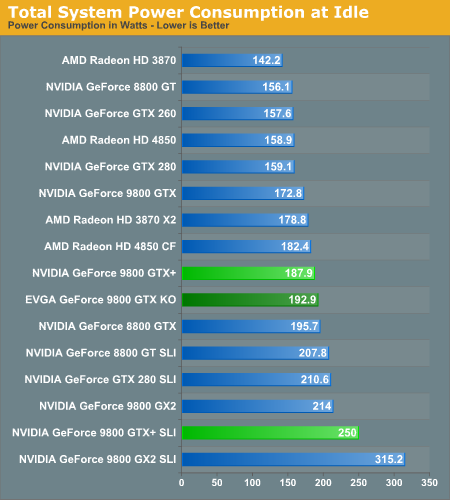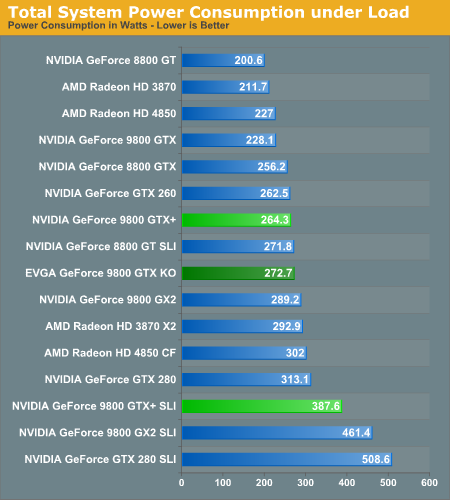NVIDIA's First 55nm GPU: GeForce 9800 GTX+ Preview
by Anand Lal Shimpi & Derek Wilson on June 24, 2008 12:00 AM EST- Posted in
- GPUs
How much power does 55nm save?
As far as we know, the GTX+ is a simple die shrink of G92 so the only differences between it and the regular 9800 GTX are clock speeds and power consumption.
Luckily EVGA sent us one of their GeForce 9800 GTX KO cards, which happens to be clocked at virtually the same speed as the upcoming GTX+:
| 9800 GTX+ | EVGA 9800 GTX KO | 9800 GTX | |
| Core Clock | 738MHz | 738MHz | 675MHz |
| Shader Clock | 1836MHz | 1836MHz | 1690MHz |
| Memory Clock | 1100MHz | 1125MHz | 1100MHz |
| Price Point | $229 | $209 - $239 | $199 |
With the 9800 GTX KO you can get the performance of the GTX+ today, without waiting for July 16th for availability. What you do lose out on however is power. At idle the new 55nm chip draws about 3% less power than the overclocked 9800 GTX and actually draws 8.7% more power than the stock-clock 65nm 9800 GTX.

Under load, the GTX+ once again draws around 3% less power than EVGA's KO edition, it would seem that the move to 55nm actually doesn't buy NVIDIA much in the way of power savings.

The Test
We're keeping the commentary to a minimum here as this is a quick preview, we'll have a full performance analysis of the entire AMD and NVIDIA product lineups early tomorrow morning as the NDA lifts on AMD's Radeon HD 4870.
| Test Setup | |
| CPU | Intel Core 2 Extreme QX9770 @ 3.20GHz |
| Motherboard | EVGA nForce 790i SLI Intel DX48BT2 |
| Video Cards | ATI Radeon HD 4850 ATI Radeon HD 3870 X2 ATI Radeon HD 3870 EVGA GeForce 9800 GTX KO NVIDIA GeForce 9800 GTX+ NVIDIA GeForce 9800 GTX NVIDIA GeForce 9800 GX2 NVIDIA GeForce 8800 GTX NVIDIA GeForce 8800 GT NVIDIA GeForce GTX 280 NVIDIA GeForce GTX 260 |
| Video Drivers | Catalyst Press Driver (8.7 beta) Catalyst 8.5 ForceWare 177.34 (for GT200) ForceWare 177.39 (for 9800 GTX+) ForceWare 175.16 (everything else) |
| Hard Drive | Seagate 7200.9 120GB 8MB 7200RPM |
| RAM | 4 x 1GB Corsair DDR3-1333 7-7-7-20 |
| Operating System | Windows Vista Ultimate 64-bit SP1 |
| PSU | PC Power & Cooling Turbo Cool 1200W |
















36 Comments
View All Comments
Ytterbium - Tuesday, June 24, 2008 - link
Hi, What are the setting you use in Crysis?Pale Rider - Tuesday, June 24, 2008 - link
Like one full page of new ATi product information smack in the middle of this preview.ashegam - Tuesday, June 24, 2008 - link
Anand or Derek,When can we expect 55nm 200 models since they are apprehensive about doing both a die shrink and new architecture together? 6 month, 1 year?
Anand Lal Shimpi - Tuesday, June 24, 2008 - link
NVIDIA probably started working on the 55nm shrink of GT200 as soon as the chip was done, so you can expect a die-shrunk version of it as soon as 6 months but I'd expect one in early 2009.-A
Mr Roboto - Tuesday, June 24, 2008 - link
Yeah how weird is that? Two companies that are such bitter rivals both use the same manufacturer. I didn't know they both used TSMC until a few weeks ago.Also I know it's just a name but I think Nvidia is retarded for their naming scheme the last few rounds. First the whole 8800GTS 640\320 512\256 then the 8800GSO\9600GSO which is basically a 9600GT and now the 9800GTX+. Really unimaginative and it just shows how much they're trying to capitalize on the 8800 name. They need to fire the guy who jumbled this thing so badly. You would think Jen-Hsun Huang would be on top of things like this. Unless this was his idea?
Anyways my 8800GTX is still kickin strong, but I'm looking forward to seeing the rest of ATI's lineup.
Clauzii - Tuesday, June 24, 2008 - link
In my world, 9800 will always be as in "ATI Radeon 9800Pro" :))feelingshorter - Tuesday, June 24, 2008 - link
Your right and a lot of people would agree. Nvidia's naming is so confusing that most people who aren't so tech savy wouldn't know if a GSO or the GS or the GTS or GT is faster. Not to mention they released the cards with different types of memory (512 vs 640) under the same name with the higher memory being slower, older version of the same card. How many people probably mistakenly bought the 640 version of the 8800GT without knowning the 512 was actually faster? Not everyone reads tech news daily.Only the less tech savy customers are the ones hurt, which is most of the customers. Although no one on anandtech would get confused, I know plenty of friends who are and ask me all the time which cards to buy. But even I have to read tech news daily just to keep up with it. This is, YANL, as one review website coined the term (yet another nvidia launch).
strikeback03 - Wednesday, June 25, 2008 - link
For that matter, the 9600GSO offerings seem to generally have less memory on a smaller memory interface, but more SPs. So maybe NVIDIA is confused over which should be faster as well.And why has Anandtech never reviewed a GSO?
formulav8 - Friday, June 27, 2008 - link
The 9600 GSO is basically the 8800GS video card renamed. Same 192 Bit memory interface and 384MB of memory. I believe 96 Shaders as well.The 9600 GT version has 64 Shaders but the clockspeeds are higher than the GS clocks and carries a 256 Bit memory bus.
Whats sad is the GSO version could beat the GT version in certain things and the GT wins in other things. They are not clearly defined as they should be since they are carrying the same Model #. nVideo has the worse naming so far.
So if you've seen the 8800GS review then you've seen the 9600 GSO reviewed...
Jason
Lonyo - Tuesday, June 24, 2008 - link
Are the Oblivion numbers in the chart really accurate?You're trying to tell me the 9800GTX+ with 9.3% better core and 7.x% better shaders and the same speed RAM gets 15% better FPS in Oblivion?
Seems a little odd, unless there are some other changes under the hood, because I don't see how a <10% change in clocks can get you 15% change in performance without something a bit weird going on.